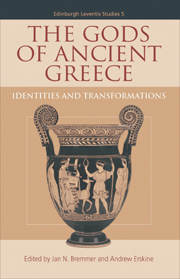Book contents
- Frontmatter
- Contents
- Preface
- List of Illustrations
- Notes on Contributors
- List of Abbreviations
- Introduction: The Greek Gods in the Twentieth Century
- 1 What is a Greek God?
- PART I SYSTEMATIC ASPECTS
- PART II INDIVIDUAL DIVINITIES AND HEROES
- 8 Zeus at Olympia
- 9 Zeus in Aeschylus: the Factor of Monetization
- 10 Hephaistos Sweats or How to Construct an Ambivalent God
- 11 Transforming Artemis: from the Goddess of the Outdoors to City Goddess
- 12 Herakles between Gods and Heroes
- 13 Identities of Gods and Heroes: Athenian Garden Sanctuaries and Gendered Rites of Passage
- PART III DIACHRONIC ASPECTS
- PART IV HISTORIOGRAPHY
- Epilogue
- Index
8 - Zeus at Olympia
from PART II - INDIVIDUAL DIVINITIES AND HEROES
Published online by Cambridge University Press: 05 August 2013
- Frontmatter
- Contents
- Preface
- List of Illustrations
- Notes on Contributors
- List of Abbreviations
- Introduction: The Greek Gods in the Twentieth Century
- 1 What is a Greek God?
- PART I SYSTEMATIC ASPECTS
- PART II INDIVIDUAL DIVINITIES AND HEROES
- 8 Zeus at Olympia
- 9 Zeus in Aeschylus: the Factor of Monetization
- 10 Hephaistos Sweats or How to Construct an Ambivalent God
- 11 Transforming Artemis: from the Goddess of the Outdoors to City Goddess
- 12 Herakles between Gods and Heroes
- 13 Identities of Gods and Heroes: Athenian Garden Sanctuaries and Gendered Rites of Passage
- PART III DIACHRONIC ASPECTS
- PART IV HISTORIOGRAPHY
- Epilogue
- Index
Summary
Olympia was the foremost sanctuary in honour of Zeus in the ancient world, and although the god had many manifestations at Olympia, none is so well known as the regal seated Olympian Zeus created by Pheidias for the temple of Zeus in c.438–432 BC (Figs. 8.1–8.3).1 Its size, c.13.5 m high, and material, ivory and gold, guaranteed its fame, and it became the prevailing image of Zeus on coinage and in other media thenceforth. More common throughout Olympia's earlier history, however, are dynamic, standing images of the god and other dedications to Zeus that emphasize his concerns with adjudication, oaths and, above all, warfare. Military matters figured heavily at Olympia, as they did at other Panhellenic sanctuaries, such as Delphi. However, the emphasis upon warfare – weapons, victories, trophies, spoils – and its close association with athletics is particularly pronounced at Olympia, where Zeus was the chief god and the primary recipient of military thank-offerings, as we know from inscriptions to the god, especially in his guise as ‘Zeus Olympios’. At no other sanctuary in the Greek world were athletic victory statues so prevalent, and their juxtaposition with military monuments is, I would argue, intentional and designed to underscore the similarities between athletics and warfare. While many gods had connections with warfare, and Zeus receives honours in this regard elsewhere, such as at Dodona, Olympia seems to represent a special case.
- Type
- Chapter
- Information
- The Gods of Ancient GreeceIdentities and Transformations, pp. 155 - 177Publisher: Edinburgh University PressPrint publication year: 2010

